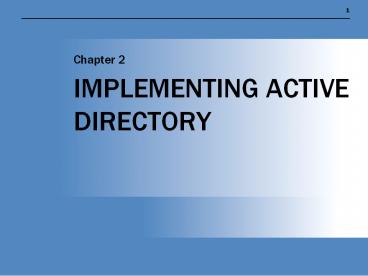IMPLEMENTING ACTIVE DIRECTORY - PowerPoint PPT Presentation
Title: IMPLEMENTING ACTIVE DIRECTORY
1
IMPLEMENTING ACTIVE DIRECTORY
- Chapter 2
2
REQUIREMENTS FOR ACTIVE DIRECTORY
- Microsoft Windows Server 2003 (Standard,
Enterprise, Datacenter) - Cannot use Web Edition for Active Directory
- Access as a local administrator
- NT file system (NTFS) partition for Sysvol
- 200 MB minimum free space
- Transmission Control Protocol/Internet Protocol
(TCP/IP) - Domain Name System (DNS) to host service location
(SRV) resource records
3
ACTIVE DIRECTORY INSTALLATION PROCESS
- Complete pre-installation tasks
- Plan and test before you install in a production
environment
4
ACTIVE DIRECTORY INSTALLATION
- Dcpromo or Manage Your Server
- If already a domain controller, Dcpromo allows
you to remove Active Directory - Operating system compatibility issues
- Microsoft Windows 95
- Microsoft Windows NT 4, Service Pack 3
5
ACTIVE DIRECTORY INSTALLATION WIZARD OPTIONS
- Domain Controller type
- Domain controller for a new domain
- Replica domain controller
- Install in a new or existing forest?
- Install in a new or existing domain tree?
- Use the appropriate names
- Domain Name System (DNS)
- Fully Qualified Domain Name (FQDN)
- NetBIOS
6
ACTIVE DIRECTORY INSTALLATION WIZARD OPTIONS
- Database and Log Folders
- Shared System Volume (Sysvol)
- systemroot\NTDS
- NTFS required
7
ACTIVE DIRECTORY INSTALLATION WIZARD OPTIONS
8
DNS REGISTRATION AND DIAGNOSTICS
- If DNS is not detected, you can choose to
automatically install and configure. Otherwise,
you must manually install and configure. - SRV resource records required
- Dynamic updates highly recommended
- Incremental zone transfers recommended
9
PERMISSIONS
- PreWindows 2000
- Windows Server 2003
10
ACTIVE DIRECTORY INSTALLATION WIZARD OPTIONS
- Directory Services Restore Mode Administrator
password - Password used to enter Directory Services Restore
Mode - Required for Active Directory maintenance
- Completing the Active Directory installation
- Confirm your configuration
- Restart your new domain controller
11
VERIFY AND FINALIZE DNS
- Application Directory partition creation
- DomainDNSZones
- ForestDNSZones
- Automatically created when Active Directory
Integrated DNS is used - Can be managed only by Enterprise Admins
- Aging and scavenging options
- Forward lookup zones and SRV resource records
12
DNS UPDATES AND RECORD STORAGE
- Dynamic updates
- Secure only
- Nonsecure and secure
- None
- Store the zone in Active Directory, named Active
Directoryintegrated - Reverse lookup zones
13
REPLICA DOMAIN CONTROLLER
- Provides load balancing and fault tolerance
- If one domain controller fails, there is another
holding the Active Directory records - Clients can use either domain controller for
authentication - DNS fault tolerance
- If Active Directoryintegrated, the records are
automatically copied to other domain controllers - If not Active Directoryintegrated, you can use a
secondary zone for fault tolerance of records
14
REPLICA DOMAIN CONTROLLER
- DNS load balancing
- Install DNS service on additional server
- Configure client computer to use the new server
as their Preferred DNS server
15
SCHEMA MODIFICATION
- Some applications modify the schema
- Examples include e-mail programs, backup
programs, and directory integration software - Must be a member of Schema Admins to install
these applications or to manually modify the
schema - Schema changes trigger replication to all domain
controllers in the forest - Default system classes cannot be modified
- Class and attribute changes cannot be removed,
but can be deactivated
16
RAISING DOMAIN AND FOREST FUNCTIONAL LEVELS
- Once complete, cannot be undone without a
reinstall - Each domain functional level can be raised
independently of other domains - Forest functional levels can be raised only when
all domains are at Windows 2000 native or higher - Domain Admins membership required to raise domain
functional level - Enterprise Admins membership required to raise
forest functional level
17
ESTABLISHING AND MAINTAINING TRUSTS
- Shortcut trust
- Used to improve resource access
- Reduces the length of the trust path
- Transitive
- Cross-forest trust
- Initially one-way can create two one-way trusts
to provide access in either direction - Available only to Windows Server 2003 forests
- Transitive
18
ESTABLISHING AND MAINTAINING TRUST
- External
- Can be used for Windows NT Server 4.0 and
Windows 2000 domain trusts - Not transitive
- Realm
- Used between third-party Kerberos implementations
- Not transitive
19
MANAGING TRUSTS
- Verifying trusts
- Active Directory Domains And Trusts
- netdom trust domain1 /dcontoso /verify
- Revoking trust relationships
- Active Directory Domains And Trusts
- netdom trust domain1 /dcontoso /remove
20
USER PRINCIPAL NAMES
- Allows users to log on without specifying a
domain separately - Can be the users e-mail address
- By default, the User Principal Name (UPN) suffix
is the same as the forest root domain name - Can add UPN suffix in Active Directory Domains
And Trusts - Can modify UPN on a per-user basis
21
SUMMARY
- Active Directory requires DNS and SRV resource
record support - Verifying Active Directory installation
- Active Directory partitions
- Schema modification and replication
- Forest and domain functional levels
- Trust types Shortcut, cross-forest, external,
realm































